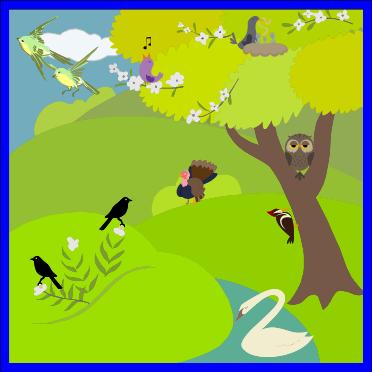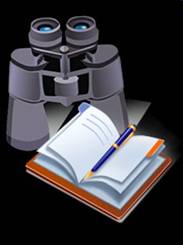Difference between revisions of "Field Ornithology"
| Line 131: | Line 131: | ||
'''Important documents to download:''' | '''Important documents to download:''' | ||
| − | |||
| + | Course overview{{pdf|http://hydrodictyon.eeb.uconn.edu/courses/fieldornithology/Field%20Ornithology%202011.pdf}} | ||
| + | Binoculars sign-out{{pdf|http://hydrodictyon.eeb.uconn.edu/courses/fieldornithology/Binocs%20signout.pdf}} | ||
| + | ID'ing exercise{{pdf|http://hydrodictyon.eeb.uconn.edu/courses/fieldornithology/Exercise.pdf}} | ||
| + | Field Notebook Instructions{{pdf|http://hydrodictyon.eeb.uconn.edu/courses/fieldornithology/Field_Notebook_Guidelines.pdf}} | ||
Revision as of 01:18, 6 June 2011
EEB 3898: Field Methods in Ornithology
Intensive Summer Session 1, June 6th - 24th, 2011 MTWThF
Instructor: Alejandro Rico
Office: Biol/Pharm 404
Phone: 860-486-0309
Office hours: variable & flexible (call, email, drop by)
Course Objectives
➢ Acquire bird identification skills
➢ Learn how to take field notes
➢ Learn and apply basic field research techniques, study design, and data analysis
➢ Develop an individual project
Course Materials
• Required
o The Sibley Field Guide to the Birds of Eastern North America
o Binoculars (available from us if you don’t have any)
o Field notepad/notebook
• Recommended
o Sibley’s birding basics
o Birding by Ear: Eastern and Central North America
o Old shoes or hiking boots, & proper outdoor clothing (poison ivy, weather)
o Insect repellent (ticks, mosquitoes)
o Sunscreen
Tentative* schedule
*: Schedule is subject to change pending weather conditions, or unforeseen birding and research opportunities.
Grading
Exams: June 15th (MIDTERM) [50 points]; June 24th (FINAL) [50 points]
Individual Project Paper:
June 14th (Intro and Methods) [30 points];
June 23rd (Final) [50 points]
Individual Project Presentations:
June 14th (Intro and Methods) [20 points];
June 22nd (Final) [25 points]
Field Notebook Submissions:
June 13th (First) [20 points];
June 21st (Final) [25 points]
Field trips = Birding exercises (5 points each):
June 9th, 10th, 13th, 20th, 21st, 23rd [30 points]
Total: [300 points]
Grading scale: A = 100-90%, B = 89-80%, C = 79-70%, D = 69-60%, F = 59-0%.
Plus/minus system will be used for the final grade.
Important documents to download:
Course overview![]() Binoculars sign-out
Binoculars sign-out![]() ID'ing exercise
ID'ing exercise![]() Field Notebook Instructions
Field Notebook Instructions![]()
Additional References & Websites
• MANUAL OF ORNITHOLOGY (Yale Univ.), by N.S. Proctor and P.J. Lynch: http://books.google.com/books?id=nQ3vLQkEWQMC&printsec=frontcover&dq=general+warbler+bill+shape#v=onepage&q&f=false
• Bibby CJ, Burgess ND, Hill DA, Mustoe S, editors. 2000. Bird census techniques. San Diego, USA: Academic Press.: http://books.google.com/books?id=Ld5wkzPp49cC&printsec=frontcover&dq=Bibby&ie=ISO-8859-1&cd=2&source=gbs_gdata#v=onepage&q&f=false
• Gill F. 2007. Ornithology. New York: W. H. Freeman and Company. : http://books.google.com/books?id=zM0tG5ApO0UC&printsec=frontcover&dq=ornithology+gill&hl=en&src=bmrr&ei=4iTsTfHvN4b2gAeg3o3ZCQ&sa=X&oi=book_result&ct=result&resnum=1&ved=0CC4Q6AEwAA#v=onepage&q&f=false
• Stiling P. 1999. Ecology: theories and application. New Jersey: Prentice Hall.
• Clark, G. A. 1999. Birds of Storrs, Connecticut and vicinity. 3rd Ed. Mansfield, CT: Natchaug Ornithological Society & Joshua’s Tract Conservation and Historic Trust.
• SORA (Searchable Ornithological Research Archive): http://elibrary.unm.edu/sora/index.php
• Cornell Lab of Ornithology “All About Birds”: http://www.birds.cornell.edu/AllAboutBirds
• Natchaug Ornithological Society: http://www.nosbird.org/ (esp. “local hotspots” http://www.nosbird.org/hotspots.html)
• Connecticut Ornithological Association: http://www.ctbirding.org/index.htm
• CT Audubon Society: http://www.ctaudubon.org/
• CT Department of Environmental Protection: http://www.ct.gov/dep/site/default.asp
Website design by Diego Sustaita

